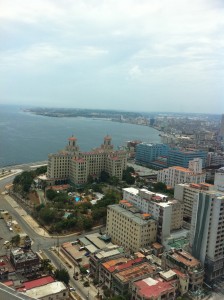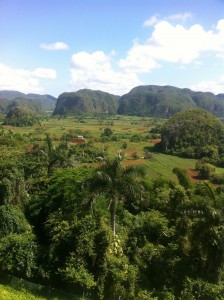
A4T Science Fair in Kabul Afghanistan. These students (4.5 to 7 yrs. old) sang the Afghan National Anthem to the audience before the Fair’s presentations.
Today’s special blog is the last commemorating a decade of Reality Tours in Afghanistan and features the insights of Marsha MacColl, on behalf of our partner Afghans4Tomorrow (A4T). On behalf of Global Exchange we thank all the tremendous energy and efforts of A4T and look forward to a dynamic future of continued collaboration.
Congratulations to Global Exchange Reality Tours on the 10th Anniversary of your tours to Afghanistan and on your partnership with Afghans4Tomorrow (A4T). Each delegation has stayed in the A4T Guesthouse since 2004, enjoying the warm hospitality of the staff. The house, located in a quiet secure area of West Kabul, has 5 guest bedrooms upstairs and a lovely garden in the back. Depending on the size of the group, the rooms sleep between 2 and 4 people. The guides who helped plan the tours and activities of these Global Exchange Reality Tours are Najibullah Sediqi and Wahid Omar, who also have volunteered with Afghans4Tomorrow for 10 years and serve on its board. Their tours have included, among other things, interesting in-depth meetings with Afghan women from all sectors of Afghan society, visits to primary schools, hospitals, universities, watching a buzkashi games and attending the International Women’s Day celebration in Kabul.
Najib has also been a wonderful guide for these delegations. The many delegates I’ve talked with over the years highly recommend these tours. They said Najib put them at ease with his warm welcome, his concern for their safety, his quick wit, compelling stories and the Afghan history he shares on the tours. Many have kept in touch with him over the years. Some delegates in fact have been inspired to get involved in helping one of the many Afghan-related NGOs (or start one of their own) after they return from the tour.

Here are some of the 35 third graders reading in their home school class. If you would like to help us raise funds for chairs and school supplies for these students, please make a donation at: http://www.afghans4tomorrow.org/donate
There have been several GXRT alumni who have helped Afghanistan through A4T since their tours. They are: Kim O’Connor (GXRT ’04), who joined A4T when she returned in 2004 and recently served as President for the past 2 and a half years; Adrienne Amundsen (GXRT ’10), who joined A4T in January ’12 after volunteering since ’10; and Asma Eschen (GXRT ’03), an honorary A4T Board member, who co-found the Bare Root Trees Project and has led a group to plant trees in Afghanistan six times since 2005. The Bare Roots group has planted/distributed a total of over 130,000 trees in rural and urban Afghanistan. See Asma’s post on this GXRT Blog in this series.
As an A4T member since 2004, I’ve enjoyed the stories and photos that many GXRT alumni have shared with me over the years. It has been a life-changing experience for many! Our board members have helped the GX program directors over the years with information they’ve needed for their delegates, guesthouse arrangements and helping delegates to meet some of our members and staff. I volunteered to teach English in our A4T school in Kabul for 10 days in 2007 and greatly appreciated Najib’s help with all the arrangements of my work and also a visit during the Nowruz holiday to Istalif village near the Shomali Valley. This reality tours program is great for travelers wanting to learn more about ordinary Afghans, their culture, history and how they’re overcoming many difficult challenges.
The NGO which inspired me to volunteer to help rebuild Afghanistan is Afghans4Tomorrow. A4T is a non-profit, non-political, humanitarian organization founded in 1998 and dedicated to the development of sustainable, community driven projects focused on education, agriculture and healthcare. A4T has an all-volunteer board residing in both the US and in Kabul. We are able perform our work thanks to the generosity of our donors and volunteers from around the world. We hire local Afghans to be the managers of our programs and teachers in our schools. We have established relationships with multiple sponsors, foundations, and non-profit organizations.

In our Shekh Yassin School, Wardak Province, 162 girls are in three Home Schools, from 1st to 6th grade. Here are the 25 first graders reading their books in Pashto.
Afghans4Tomorrow currently operates a school in Kabul and one in Wardak Province. Our school, located in the Chelsetoon area of Kabul, opened in 2004 and has nearly 300 students, 170 girls in kindergarten through 9th grade and 110 boys in 1st through 7th grade. This school is one of the best private schools in Kabul. We plan to add 10th grade this year. The school started in 2005 as a “catch-up” school for older girls who had been deprived of an education during the wars. Now most all those students have caught up and are the normal age for their grade level. Several A4T alumni have graduated from high school and are in a community college or a university.
Our School in Shekh Yassin, which opened in 2005, serves students from three villages in the Chak district of Wardak Province. It has a boys’ school of 568 students, in 1st to 9th grades in two shifts per day, and more than 175 girls in three Home Schools, from 1st to 6th grade. We plan to add 7th grade this year. We are unable to add 10th grade to the boys’ school until we can build 3 new classrooms.
A4T held its second Science Fair program on Oct. 15, 2011 in which 17 students participated in 9 teams. They did research on their experiments for one month, assisted by their science teacher.
The students presented their research results to 4 qualified judges at the fair. After their evaluation the judges gave prizes to the top 3 winning teams. The project that won 1st place showed the filtration of dirty water using four kinds of sand and one kind of charcoal. Government officials, private school principals and the media were invited to attend the Science Fair celebration. A4T hopes to see this same program in all government and private schools throughout Afghanistan in the future.
Afghans4Tomorrow’s goal for both schools is to help improve Afghanistan’s very low literacy rate, to provide a superior education and to have a substantial number of our graduates continue to college.

Teacher demonstrates an experiment in copper and iron ions in solution to a 7th grade Chemistry Class at A4T Boys School in Shekh Yassin, Wardak.
Since 2007 A4T has operated the A4T’s Abdullah Omar Health Post in Sheikh Yassin village which provides a doctor, pharmacist and staff offering basic health care, medicines and immunizations. Last year A4T added a midwife to better serve the women coming for pre-natal checkups, deliveries and post-natal and baby checkups and to help reduce the high maternal and infant mortality rates in Afghanistan. Our health post has improved the lives of thousands of people each year.
A4T’s Agriculture Stream is pleased to report the successful training of 120 rural farmers the last two years by helping them to raise poultry and supplying them with equipment for their chicken coops, and healthy birds. The women poultry farmers sell the eggs to help support their family.
Volunteers are needed to help A4T continue there great work. Please visit their website to learn about their projects, affiliates, members, photos, videos, and how you can make a difference.
Join Us on an Upcoming Reality Tour to Afghanistan! Learn more. Visit our website for all you need to know about upcoming transformative journeys.



























